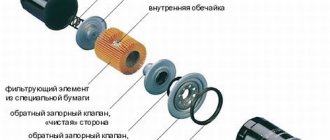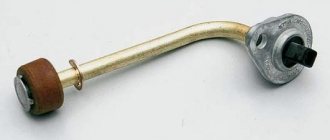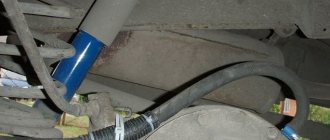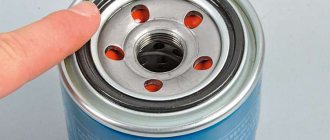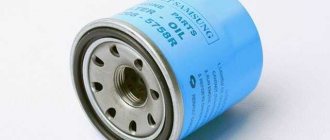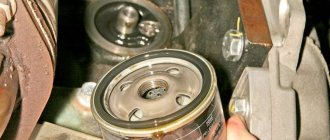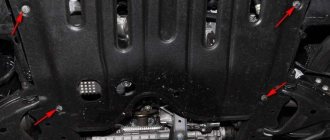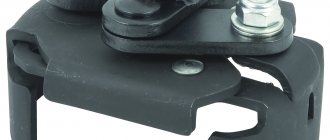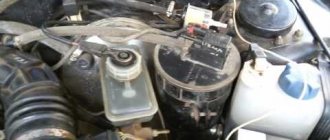Filter functions
Oil is required to continuously lubricate your car's engine. However, dirty liquid can cause significant damage to it. In other words, having a working oil filter is vital to maintaining engine performance.
This part performs several key functions:
- Cleans oil from contaminants such as metal particles and component oxides.
- Captures and holds debris until the filtration system is replaced.
- Helps avoid excessive hydraulic resistance and ensures clean oil is supplied to the engine for optimal engine performance.
By purchasing high-quality synthetic oils that are cleaner, the filter can last much longer. However, sooner or later the filter stops coping with oil contamination, and then the bypass valve comes to its aid.
Filter element – “curtain”
It is the “curtain” that is the main element, and all oil filters have it. It is a thick layer of filter paper made from a mixture of glass, synthetic and cellulose resins. The paper itself is impregnated with phenol-formaldehyde resins, which is why it is durable and provides a long service life.
This filter paper is folded like an accordion and enclosed in a metal cylinder. The design represents the basis of the filter. In fact, there is nothing complicated in the design, but the operating efficiency of such filters is high. But in any case, such devices are not capable of retaining all impurities that enter the lubricant from the outside.
Bypass valve task
Gradual clogging of the filter leads to a limitation of the liquid supply. Sometimes the oil pump is forced to supply more oil to the filter than it can process. Because not having the required volume of components to lubricate all the pistons can seriously damage your engine—and even dirty, unfiltered oil is better than nothing—quality modern filters are equipped with a bypass valve to ensure continuous fluid flow in all conditions.
For example, if the engine is not warmed up (cold oil has a thicker and viscous texture) or runs at high speeds (for example, when overtaking), not enough oil begins to pass through the filter. In this case, the bypass valve helps: it allows sufficient flow of engine oil to bypass the filter. The lubricating fluid itself is partially cleaned. If the filter is clogged, a pressure spring inside it is also activated, opening the bypass valve. When the engine is warm and running at moderate speed, the valve remains closed and the engine oil is completely filtered.
Despite the popular misconception, the key role in opening and closing the valve is played not by the pressure in the oil system itself, but by its differences. Specific indicators that trigger the device are indicated on the parts themselves. Typically, most valves operate at a pressure differential of 1 to 2 bar. Thus, the valve will remain closed even at extremely high absolute pressure levels in the system, if it has already established at a certain level. In this case, the oil continues to move towards the engine through the filter elements. This phenomenon also destroys the popular myth that the bypass valve can remain open for a long time: this violates the original principle of operation of the device and harms the entire oil system. After all, the engine will not work for long on dirty, unfiltered oil.
Thus, the main task of the bypass valve is to prevent “oil starvation” of the engine. Sometimes the oil system cannot cope with the load on its own. The engine and engine fluid did not have time to warm up in frosty weather, an attempt to overtake sharply increased the number of revolutions, and the oil filter even managed to become clogged? In such cases, the bypass valve, sacrificing the purity of the lubricating components, opens and provides the required fluid. However, it is worth understanding that this part will not be able to help out forever. Oil filters still play a key role in the entire engine lubrication system, so using high-quality motor oil and timely filter replacement will significantly extend the life of your car's engine.
Filtration fineness[ | ]
To assess the filtration fineness, there are two parameters - nominal filtration fineness and absolute filtration fineness. Nominal filtration fineness is the size of particles retained by the filter by 95%, absolute filtration fineness is the size of particles completely retained by the filter.
In domestic practice, it is customary to evaluate filters by their nominal filtration fineness. For example, in road construction equipment, the nominal filtration fineness of most filters for hydraulic drive systems is 25-40 microns. In aviation, filtration requirements are stricter, and the nominal filtration fineness of most filters is 5 microns or less.
- Oil change Nissan Murano Photo instructions on how to change the oil and oil filter on a Nissan Murano
- Oil change Solaris 16 Photo instructions on how to change the oil and oil filter Hyundai Solaris
- Oil change Mitsubishi Lancer 9 Photo instructions on how to change the oil and oil filter of the Lancer 9 16 engine
- Oil change Ford Kuga 2. Photos, instructions on how to change engine oil Kuga 2
Why do you need an oil pump pressure reducing valve?
As you know, oil is supplied to moving engine parts under a certain pressure created by a running pump. Without this, the lubricant would simply flow into the crankcase, exposing the elements of the crank and gas distribution mechanisms to increased friction and overheating. But too high a pressure is also dangerous for the engine. Gaskets, seals, seals are not able to withstand exceeding its normal values. Because of this, oil begins to ooze from under them, and can also enter the power and cooling system of the power unit.
It is to reduce the lubricant pressure in the system that the oil pump pressure reducing valve is designed. The word “reduction” itself is often used in mechanical engineering, denoting a reduction, reduction, or weakening of something. In our case, this refers to oil pressure.
At what pressure should the pressure reducing valve operate?
But how can you understand that the pressure has increased or, conversely, decreased? And what should it even be like? The optimal oil pressure in the system can be found by looking at the owner's manual. It will be different for different brands and models of cars. For example, the pressure reducing valve of the Tavria oil pump operates at 0.55 MPa. Approximately the same indicators are relevant for most Lada cars.
You can measure oil pressure by connecting a special liquid pressure gauge to the system into the pressure sensor mounting socket. Before this, the engine must be warmed up to operating temperature. All measurements are made with the engine running.
Where is he located?
The oil pump pressure reducing valve is most often located on the cover of this device, which is located in the lower front part of the engine block behind the generator drive pulley. Sometimes it can also be installed on the oil filter housing.
There are two types of valves: built-in and detachable. In the first case, the oil pump and pressure relief valve are a single structure that cannot be disassembled. In the second, the pressure control mechanism is removed from the pump using a tool and can be repaired separately.
Main selection criteria
When choosing a new spare part, you should consider only high-quality items from reliable manufacturers.
When choosing a filter, you should adhere to the following basic criteria:
- durable metal case;
- high-quality sealing edge;
- perfect appearance, without any visible defects (cracks, scratches, chips);
- availability of certificates of quality, compliance and complete information about the manufacturer.
Important! You should not save when buying an oil filter, because it affects the stability and service life of the engine.
FILTERS DEVICE
Oil filter
consists of a housing in which there is a filter element and, if necessary, bypass, anti-drainage and anti-drain valves.
Depending on the housing design, filters can be of two types: - non-separable (spin-on)
, which are currently most widespread due to their compactness, low cost and ease of replacement;
- dismountable (replaceable cartridge)
with a replaceable filter element, used less frequently, as they have increased dimensions and are less convenient to maintain.
In Fig: Non-separable oil filter 1 – housing; 2 – filter element (curtain); 3 – bypass valve; 4 – anti-drainage valve; 5 – anti-drain valve The filter element (“ curtain
This paper has high porosity, and thanks to its impregnation, it is durable, water- and oil-resistant.
To achieve the maximum possible filter surface area with minimal filter dimensions, the paper is laid in a special way, usually in the form of a multi-beam “star”. Volumetric filter elements made of cotton, synthetic and artificial fibers are used less frequently. A bypass valve
is sometimes called a safety valve, bypass valve, or bypass valve.
Its purpose is to ensure a guaranteed supply of engine oil to the engine lubrication system in the event that it cannot pass through the filter element if it is completely clogged or the oil viscosity is too high at low temperatures. The response pressure of the bypass valve is set depending on the engine design and is in the range of 0.55–2.6 kg/cm2 for different models. valve
prevents oil from draining from the filter and oil passages into the crankcase after the engine is stopped.
This eliminates the possibility of a delay in the supply of oil to the lubrication system due to the formation of an air lock during subsequent start-up. The most common design of an anti-drainage valve is a spring-loaded rubber disk that closes the inlet holes in the filter housing from the inside. An anti-syphon valve
is usually installed in permanent filters in combination with a bypass or anti-drain valve and prevents oil from pouring out of the housing through the outlet when replacing a used filter.
The absence of some valves in the filter
- the filter is placed on the engine so that oil cannot leak out of the housing, so there is no need for anti-drainage and anti-drain valves;
- The bypass valve is installed outside the filter directly on the engine.
Repair and adjustment of the oil pump pressure reducing valve
It is possible to understand whether the pressure reducing valve is suitable for further use only by dismantling it and disassembling it. This way it will be possible to diagnose all its elements. If there are deposits on the valve body, they must be washed off with gasoline, kerosene or carburetor cleaning fluid. It is also worth carefully inspecting the spring. If it shows signs of stretching, compression or deformation, it needs to be replaced.
When you have completely reassembled the valve, check its operation by simply pressing on the ball (piston). If it is pressed in with force and returns back, locking the housing channel, most likely the mechanism is working.
Adjustment of the oil pump pressure relief valve is carried out after the pressure relief valve is installed in the device body. The process is carried out by compressing or releasing the spring by unscrewing (twisting) the thrust screw. At the same time, oil pressure in the system is measured using a liquid pressure gauge. The adjustment, of course, is carried out with the engine not running, and the pressure measurement is carried out with the engine running.
GENERAL INFORMATION
Automotive oil filters
must meet the following requirements:
- have sufficient dirt holding capacity - the ability to retain and accumulate a significant amount of oil contaminants, which mainly depends on the size of the filter element and determines the service life of the filter;
- ensure optimal fineness of screening out contaminants - determined by the pore size of the filter element;
- have a small hydraulic resistance - to facilitate the supply of thickened oil to the rubbing vapors during a cold start of the engine;
- have sufficient strength of the housing and a reliable seal at the connection to the motor - in case of an emergency increase in pressure in the lubrication system or external mechanical influences.
Oil purification in the engine lubrication system can be carried out according to two main schemes:
— full-flow
– including one filter through which all the oil supplied by the oil pump is pumped;
In Fig: Full-flow diagram of the lubrication system of a car engine 1 – engine oil sump (pan); 2 – oil pump; 3 – full-flow oil filter
— combined
– including, in addition to a full-flow filter, a partial-flow filter or, in some cases, a centrifuge;
In Fig: Combined diagram of the lubrication system of a car engine 1 – engine oil sump (pan); 2 – oil pump; 3 – full-flow oil filter; 4 – partial flow filter
